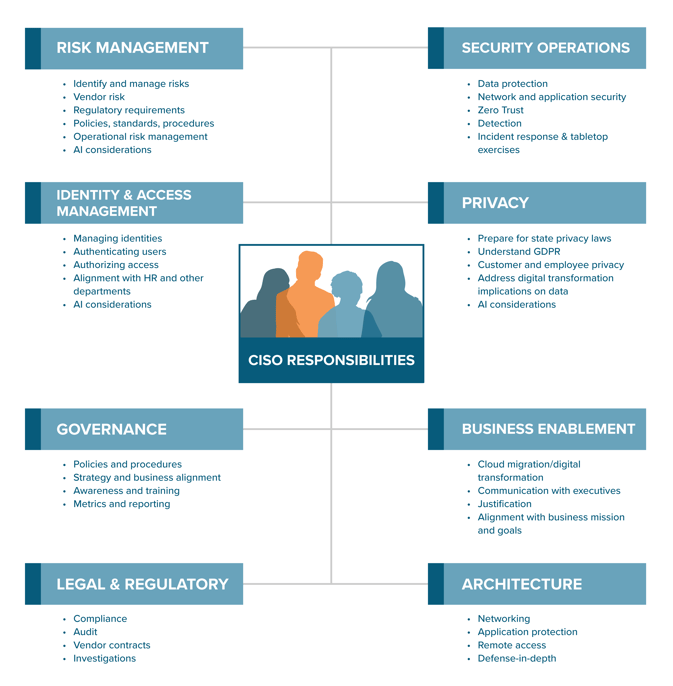Updated on: August 22, 2025

The Chief Information Security Officer (CISO) is the senior executive responsible for safeguarding an organization’s information and data security. Since the role’s emergence, the scope has expanded dramatically as today’s CISOs are no longer limited to IT defense, but are strategic business leaders driving resilience, compliance, and safe adoption of emerging technologies like AI. Increasingly, CISOs are positioned alongside CEOs and Boards, guiding not just security posture but overall business direction.
Security programs under today’s CISOs include, but are certainly not limited to: risk management, security operations, identity and access management, privacy, governance, business enablement, legal, and architecture. The role’s importance is clear: attacks are increasingly AI-powered, supply chains more interconnected, and the costs of cybercrime continue to rise into the trillions globally. Additionally, CISOs are taking initiative to ensure cybersecurity is baked into wider business operations, and this requires a deep understanding of an organization’s business objectives.
Reporting Structure and Executive Impact
As the CISO role has expanded, so too has its authority and influence across the business. No longer viewed as a cost center, CISOs are recognized as essential to protecting revenue, enabling digital transformation, and guiding organizations through complex risks from AI adoption to M&A due diligence. Today, their programs are not only protecting assets but actively shaping business growth and resilience strategies.
The influence of CISOs has grown dramatically in just two years. Splunk and Oxford Economics found that 82% now report to CEOs, up from 47% in 2023, while 83% attend board meetings on a regular basis. This elevated presence ensures that security is debated at the highest levels and positions the CISO as a true business strategist, not just a security lead.
The Rise of AI
CISOs must now lead through an AI-driven security environment that is rapidly reshaping both risks and opportunities. Threat actors are weaponizing generative AI to create highly convincing phishing campaigns and social engineering attacks, erasing the telltale errors that once made them easy to spot. These advancements are driving measurable damage. Global studies show financial losses from AI-enhanced phishing and fraud continue to rise year-over-year. At the same time, defenders are turning to AI for real-time anomaly detection, predictive threat intelligence, and automated incident response. According to Splunk's CISO Report, CISOs with strong board relationships are 43% more likely to deploy generative AI across threat detection, response, and hunting functions.
AI is not only transforming the threat landscape, it is also reshaping the business. Executives across departments are racing to embed AI into their operations, from product development to customer experience. This creates both opportunity and new layers of enterprise risk. CISOs are increasingly expected to serve as AI governance leaders, building policies that balance innovation with security and compliance, while coordinating across the C-suite.
To succeed, CISOs must navigate dual responsibilities: deploying AI internally to strengthen their own security programs, and externally guiding the business through AI adoption safely and strategically. This requires proactive communication with executives, clear governance frameworks, and continuous oversight of how AI impacts risk. In many ways, AI is no longer just a tool for security, it has become a defining force in the evolution of the CISO role itself.
Privacy
The regulatory environment has expanded beyond GDPR and CCPA, with newer laws like CPRA, the Colorado Privacy Act, and the EU AI Act shaping how organizations approach security and compliance. These rules tie data protection directly to AI governance, requiring CISOs to work closely with legal and compliance teams to ensure transparency in how data is collected and used.
To manage this growing complexity, CISOs are increasingly partnering with Chief Privacy Officers (CPOs) to align security and privacy programs. Together, the CISO and CPO balance technical security with privacy-by-design and compliance, ensuring organizations can adapt to shifting laws while maintaining customer trust.
The Future of the CISO
The CISO role has seen significant changes in its responsibilities, and all data indicates that this position will continue to gain authority and influence. The future of this position is deeply entwined with technological shifts, trends, regulations, and advances, and because of this, proactivity is key. CISOs must be able to adapt to these changes, communicate their cause, and even embrace these emerging trends where they can. The future of the CISO is extremely dynamic, just as dynamic as the cybersecurity landscape, but so long as these priorities are actualized, CISOs have the best chance to effectively safeguard their organizations and keep their assets secure.